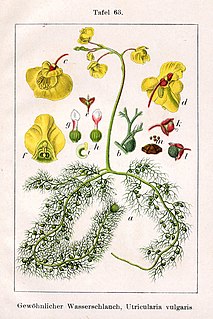
Utricularia, commonly and collectively called the bladderworts, is a genus of carnivorous plants consisting of approximately 233 species. They occur in fresh water and wet soil as terrestrial or aquatic species across every continent except Antarctica. Utricularia are cultivated for their flowers, which are often compared with those of snapdragons and orchids, especially amongst carnivorous plant enthusiasts.
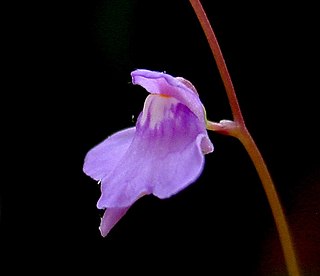
Utricularia amethystina, the Florida purple bladderwort, is a variable species of terrestrial bladderwort native to Bolivia, Brazil, Guyana, Peru, and south-west Florida. The small flowers can be purple, lilac, white, bluish, cream, or bright yellow, and are also highly variable in size and shape.
Utricularia delicatula is a terrestrial species of bladderwort and is unique within its genus in being endemic to New Zealand. The specific epithet is Latin for "dainty" and refers to the small flowers of this species. This species has a small geographic range, being found in the northern half of the North Island at low elevations in the Waikato and in Northland but also farther afield on Chatham Island in the east.
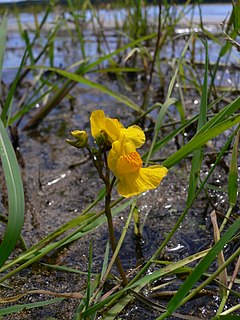
Utricularia australis is a medium-sized, perennial species of aquatic bladderwort. This species has a vast geographic range, being found throughout Europe, in tropical and temperate Asia including China and Japan in the east, Central and Southern Africa, Australia and the North Island of New Zealand. The specific epithet "australis" is Latin for "southern" and reflects the fact that the discovery of this species was made in Australia in 1810.
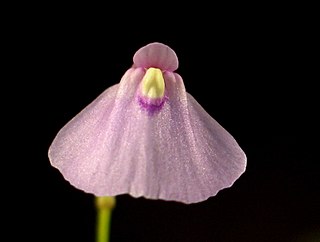
Utricularia dichotoma, commonly known as fairy aprons, is a variable, perennial species of terrestrial bladderwort. The specific epithet is Latin for "dividing into pairs" and refers to the double arrangement of flowers which this species often displays.

Utricularia gibba, commonly known as the humped or floating bladderwort, is a small, mat-forming species of carnivorous aquatic bladderwort. It is found on all continents except Antarctica.
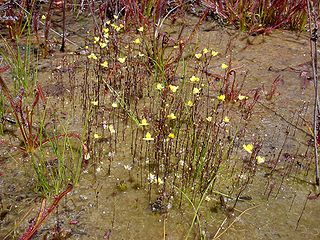
Utricularia subulata, the zigzag bladderwort, is a small annual, terrestrial carnivorous plant that belongs to the genus Utricularia. It is the most widely distributed species in the genus, being almost pantropical.

Utricularia biloba, the moth bladderwort, is a perennial, terrestrial or aquatic carnivorous plant that belongs to the genus Utricularia. It is endemic to Australia with a distribution along the coastal regions of New South Wales and Queensland.

Utricularia resupinata, popularly known as lavender bladderwort or northeastern bladderwort, is a small perennial subaquatic carnivorous plant that belongs to the genus Utricularia. It is native to eastern Canada, the United States, and Central America. This plant species has an interesting etymology, growth pattern, ecology, and research history. As a plant that is threatened or endangered in many of the States where it is found, it is a candidate for sound conservation efforts.

Utricularia aurea, the golden bladderwort, is a medium- to large-sized suspended aquatic carnivorous plant that belongs to the genus Utricularia. It is the most common and widespread suspended aquatic species in Asia. Its native distribution ranges from India to Japan and Australia.
Utricularia floridana, the Florida yellow bladderwort, is a large affixed aquatic carnivorous plant in the bladderwort genus within the bladderwort family). It is a perennial plant that is endemic to southeastern United States.

Utricularia inflata, commonly known as the swollen bladderwort, inflated bladderwort, or large floating bladderwort, is a large suspended aquatic carnivorous plant that belongs to the genus Utricularia. It is a perennial that is native to the southeastern coastal plains of the United States. It has often been confused with U. radiata, which is similar but smaller than U. inflata. Since 1980, U. inflata has been reported to exist in locations beyond its traditional range, such as the Adirondack Mountains in New York, southeastern Massachusetts, and in Washington State. Studies on the populations in the Adirondacks suggest that an introduction of U. inflata to a location where it naturalizes can lead to altered sediment chemistry by reducing the net primary productivity of native species. It is also listed by the state of Washington as a problematic species because of the dense mat-forming habit of this aquatic Utricularia. It is one of the few carnivorous plants that can be invasive.
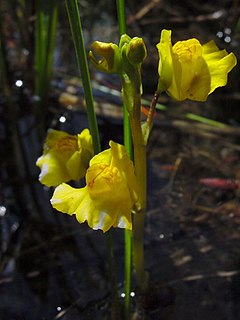
Utricularia macrorhiza, the common bladderwort, is a perennial suspended aquatic carnivorous plant that belongs to the genus Utricularia. U. macrorhiza is native to North America and eastern temperate Asia.

Utricularia intermedia, the flatleaf bladderwort or intermediate bladderwort is a small, perennial carnivorous plant that belongs to the genus Utricularia. It is usually found affixed to the substrate but it can also survive suspended in a body of water. U. intermedia is a circumboreal species and is found in North America, Asia, and Europe.
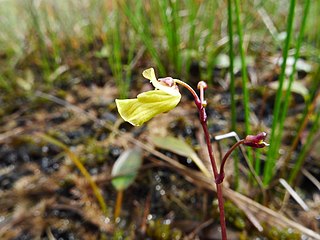
Utricularia ochroleuca, the yellowishwhite bladderwort, pale bladderwort, or cream-flowered bladderwort, is a small, perennial carnivorous plant that belongs to the genus Utricularia. It is usually found affixed to the substrate. U. ochroleuca is a circumboreal species and is found in North America, Asia, and Europe.

Utricularia radiata, the little floating bladderwort, is a medium-sized suspended aquatic carnivorous plant that belongs to the genus Utricularia. U. radiata is endemic to North America.

Utricularia cornuta, the horned bladderwort, is a small to medium-sized, probably perennial carnivorous plant that belongs to the genus Utricularia. U. cornuta is endemic to North America and can be found in the Bahamas, Cuba, Canada, and the United States. It grows as a terrestrial or subaquatic plant in marshes, swamps, and pools in shallow waters, mostly at lower altitudes. It was originally described and published by André Michaux in 1803.

Utricularia sandersonii, Sanderson's bladderwort, is a species of flowering plant in the bladderwort family. Originally described and published by the British botanist Daniel Oliver in 1865, it is a carnivorous evergreen perennial, endemic to northern KwaZulu-Natal and Transkei in South Africa.
There are fourteen species of carnivorous plants occurring in New Zealand, and four species that have been known to occur in the past.
















